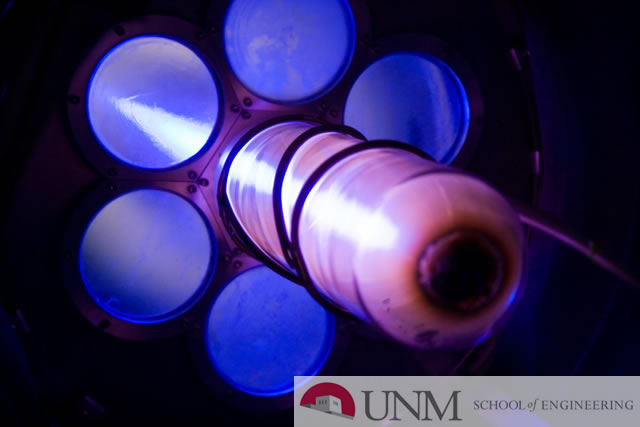
Electrical and Computer Engineering ETDs
Publication Date
1-28-2015
Abstract
Building on a unique two-step, simple MBE growth technique, we have investigated possible dislocation locking mechanisms by dopant impurities, coupled with artificially introduced oxygen. In the case of n-type Ge grown on Si, our materials characterization indicates that the dislocation density (DD) can reach the \uf07e105 cm-2 level, compared to p-type and undoped Ge on Si (GoS). We note that our Ge film covers the entire underlying Si substrate at the wafer scale without mesas or limited-area growth. In this presentation, we will focus on the use of n-type impurity (phosphorus) diffusing from the Si substrate and the introduction of O at the Ge-Si interface. The O is introduced by growing a thin chemical SiO2 layer on top of the Si substrate before Ge epitaxy begins. Z-contrast cross-sectional TEM images suggest the presence of oxygen precipitates in n-type Ge, whereas these precipitates appear absent in p-type Ge. These oxygen precipitates are known to lock the dislocations. Supporting the argument of precipitate formation, the TEM shows fringes due to various phase boundaries that exist at the precipitate/Ge-crystal interface. We speculate that the formation of phosphorus (P) segregation resulting from slow diffusion of P through precipitates at the precipitate/Ge-crystal interface facilitates dislocation locking. Impurity segregations in turn suppress O concentration in n-type Ge indicating reduced magnitude of DD that appears on the top surface of n-Ge compared to p-Ge film. The O concentrations (1017 to 1018 cm-3) in the n- and p-type GoS films are measured using secondary ionization mass spectroscopy. We also demonstrate the technique to improve the Ge epitaxial quality by inserting air-gapped, SiO2-based nanoscale templates within epitaxially grown Ge on Si. We have shown that the template simultaneously filters threading dislocations propagating from Ge-Si interface and relieves the film stress caused by the TEC mismatch. The finite element modeling stress simulation shows that the oval air gaps around the SiO2 template can reduce the thermal stress by 50% and help reduce the DD. We have then compared the structural and electrical characteristics of n-type Ge films with its p-type counter parts. In n-type Ge, the DD decreases from \uf07e109cm-2 near the Ge-Si interface to \uf07e105 cm-2 at the film surface. In contrast, we observe 5\uf0b4107 cm-2 TDD at the film surface in p-type Ge. The full width at half-maximum for our n-type Ge(004) XRD peak is ~70% narrower than that of p-type Ge. As a stringent test of the dislocation reduction, we have also fabricated and characterized high-carrier-mobility MOSFETs on GoS substrates. We also report p- and n-MOSFETs with μeff of 401 and 940 cm2/V-s and a subthreshold slope of 100 and 200 mV/decade, respectively. These effective mobilities show an exceptional 82 and 30% improvement over that of conventional Si channel MOSFETs. We also investigate the optical quality of ultra-low DD GoS film by measuring photoluminescence (PL). The n-type Ge PL main peak shows pronounced tensile-strain (x0.8%) than that of p-type which is an indicator of direct BG shrinking at the \u0413 band-edge. Going beyond epitaxial engineering and device fabrication, we have also recently demonstrated a scalable path to create a 2D array of Ge quantum dots (QDs) on responsive SiGe substrates based on elastic mechanical deformation and subsequent SiGe compositional redistribution, coupled with MBE growth. For large-scale manufacturing of single-electron transistors, we have also demonstrated that a spatially structured elastic compressive stress to the SiGe substrate with thermally annealing leads to a compositional redistribution of Si and Ge in the near-surface region of SiGe substrates, forming a 2D array of Ge-depleted nanoscale regions. Based on these latest findings, we have also begun to chart a future direction for my research group, where one can explore new advanced device architectures, such as Si-compatible, optically actuated, Ge-quantum dot-based field effect transistors.
Keywords
Germanium, Silicon, Epitaxy, MOSFETs, Quantum Dots
Sponsors
National Science Foundation
Document Type
Dissertation
Language
English
Degree Name
Electrical Engineering
Level of Degree
Doctoral
Department Name
Electrical and Computer Engineering
First Committee Member (Chair)
Krishna, Sanjay
Second Committee Member
Balakrishnan, Ganesh
Third Committee Member
Feezell, Daniel
Recommended Citation
Ghosh, Swapnadip. "LARGE-AREA, WAFER-SCALE EPITAXIAL GROWTH OF GERMANIUM ON SILICON AND INTEGRATION OF HIGH-PERFORMANCE TRANSISTORS." (2015). https://digitalrepository.unm.edu/ece_etds/97
